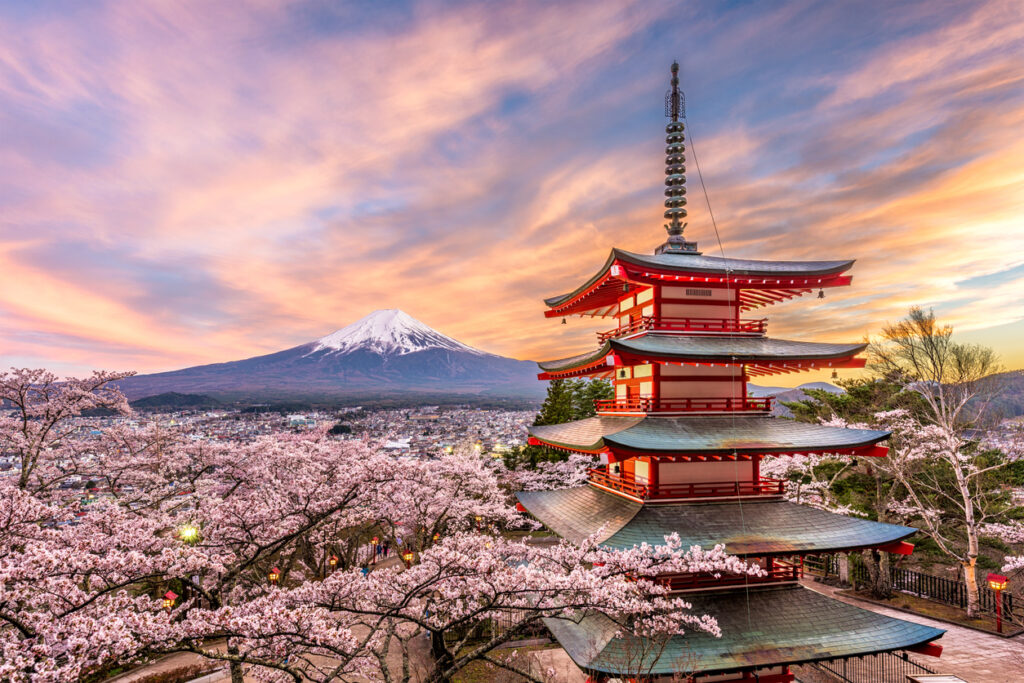Mount Fuji, located on Honshu Island, is Japan’s highest peak at 3,776 meters above sea level. Its majestic presence and perfect symmetry make it one of the country’s most iconic symbols. In addition to being one of the most recognizable mountains in the world, Mount Fuji is a highly popular tourist destination and plays a significant role in Japanese culture and history.
Tourism at Mount Fuji attracts visitors from all over the world. The climbing season typically takes place between July and September when weather conditions are most favorable. During this period, thousands of people ascend the mountain, often following well-marked trails leading to the summit.

Climbing Mount Fuji can be challenging but is accessible to people with varying levels of experience. There are four main climbing trails, each offering different levels of difficulty and stunning landscapes. The ascent usually begins in the afternoon or evening so climbers can witness the sunrise from the summit—a highly cherished spectacle.
The increasing number of visitors has brought significant challenges. Overtourism has resulted in issues such as litter accumulation, trail degradation, and overall environmental impact. To address these problems, the government of Yamanashi Prefecture has implemented various measures, including the introduction of an entrance fee and a daily visitor limit. These actions aim to preserve the environment and ensure a more sustainable experience.
Additionally, the influx of tourists has led to further restrictions, such as closing access gates at night to prevent nocturnal ascents, which can be both dangerous and challenging for maintenance efforts.
For those planning to visit Mount Fuji, it is advisable to check the weather and volcanic activity, as the mountain is an active volcano. Ensuring proper preparation with appropriate clothing for cold temperatures, sudden weather changes, and sufficient climbing supplies is essential.
Mount Fuji is a key attraction in Japanese tourism, drawing both local and international visitors. Beyond its significance as a climbing destination, the mountain also plays a role in cultural events and festivals. Tourism at Mount Fuji contributes significantly to the local economy and promotes Japan on the global stage.
As of July 1st, Mount Fuji began a new climbing season with significant changes to visitor regulations. While the climbing season will continue until mid-September, new restrictions aim to mitigate the impacts of overtourism—a phenomenon where excessive visitor numbers lead to environmental degradation.
Starting in 2024 and for an indefinite period, all visitors to Mount Fuji will be required to pay a “tourism fee” of 2,000 yen. Additionally, local authorities have established a daily limit of 4,000 climbers.
These measures have been implemented to protect the environment and ensure a more sustainable and enjoyable experience for everyone. The collected fees will be allocated to conservation and maintenance projects for the mountain, as well as efforts to control tourist flow and reduce the environmental impact caused by high visitor numbers. These rules aim to balance the preservation of Mount Fuji with the desire of millions to enjoy its majestic beauty and breathtaking trails.
The issue of overtourism at Mount Fuji has intensified in recent years, especially following Japan’s reopening to international tourism after pandemic restrictions. Before the temporary halt in visits, in 2019, authorities had already warned about the impact of the high visitor numbers, with around 5 million people climbing the mountain annually—nearly double the figure from the beginning of the decade. With these new measures, it is hoped that a balance can be achieved between preserving the mountain and meeting the desires of millions of people to explore its awe-inspiring beauty and trails.
In addition to entry restrictions, it was announced that access gates to Mount Fuji will remain closed from 4:00 PM to 3:00 AM. This measure aims to prevent nocturnal climbs, which have become one of the biggest challenges for site maintenance. Through these actions, authorities hope to balance the preservation of Mount Fuji with the experience of millions of visitors who wish to explore the mountain’s beauty and trails.
Mount Fuji is not just a tourist attraction—it has been a UNESCO World Heritage Site since 2013, underscoring its historical and cultural significance. The mountain, rising nearly 3,800 meters, is still an active volcano, though it has not erupted since the early 18th century. Its cultural importance is further highlighted by its sacred status in the Fuji-ko religion, which reveres Fuji as the highest point in Japanese territory. For years, followers of this religion have advocated for rules that minimize disruptions to their traditions caused by tourism.
Before visiting, it is advisable to check the official website for weather alerts and information about volcanic activity. With these measures, authorities aim to balance preservation and respect for the mountain with the desire of millions of people to experience its majestic beauty and stunning trails.
Mount Fuji remains an emblematic and spiritual destination, profoundly impacting both Japanese culture and the tourist experience in Japan. With new measures and growing awareness, it is hoped that Mount Fuji can be appreciated by future generations while remaining protected and respected.
The mountain serves as a reminder of the importance of conservation and environmental responsibility, highlighting the need to balance the desire to explore and admire with the necessity of protecting and preserving. Through recent measures and increasing awareness of tourism’s impact, Mount Fuji can continue to testify to the harmony between humanity and nature, offering enriching and memorable experiences to all who have the opportunity to witness its grandeur.

